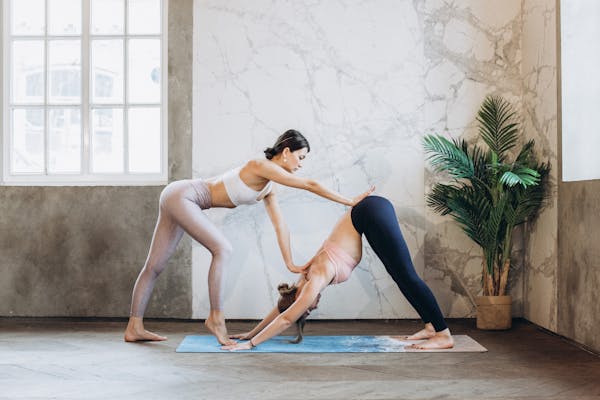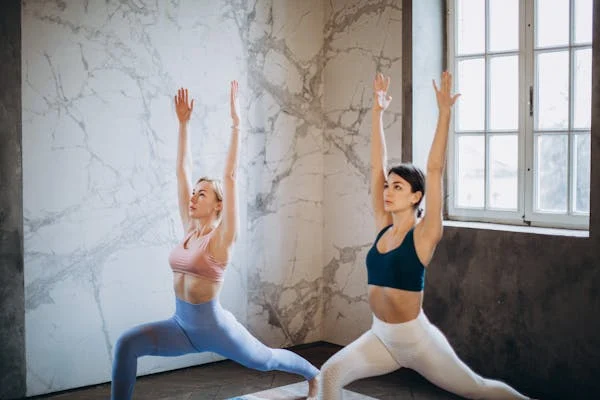Table of Contents
Introduction
Top Yoga Poses is the ancient practice that links physical postures (asanas), breathing, and meditation to improve both the physical and mental well-being.
A balanced practice of yoga contains different asanas that target all parts of the body, aiding in building up strength, flexibility, and awareness. Among numerous asanas, there are particular ones that need to be practiced to create a balanced yoga routine, providing an all-around holistic approach to well-being.
In this blog, we will explore the ten asanas of yoga that form the foundation of a balanced yoga practice. These ten asanas of yoga have been chosen for their ability to engage different muscle groups, promote mental focus, and improve overall body alignment.
Whether you’re a beginner or an experienced yogi, incorporating these ten asanas of yoga into your practice will help you maintain balance in both body and mind.
1. Mountain Pose (Tadasana)
Mountain Pose, or Tadasana, is the base of all standing poses and is often the starting point for many sequences. Although it seems easy, Tadasana is very important to establish body awareness and alignment. It sets the whole tone for the practice, allowing the rest of the ten asanas of yoga to be executed with proper alignment.
Benefits of Tadasana:
Improves posture by aligning the spine.
Strengthens the legs, thighs, and core.
Improves mental concentration and balance.
Increases body consciousness.
How to Practice Tadasana:
Stand upright with your feet together, pushing down through your heels.
Activate your thighs, lift your kneecaps, and extend your spine.
Relax your shoulders and open your chest.
Stretch your arms out to the sides of your body, with your palms facing forward.
Hold the pose for 30 seconds to 1 minute, focusing on your breath.
Tadasana is more than standing still; it is grounding the body and mind. It is the starting position for many of the ten asanas of yoga, which creates a stage for fluid transitions and alignment throughout the practice.

2. Downward Dog (Adho Mukha Svanasana)
Downward Dog is probably one of the most commonly known poses, and it remains one of the foundational ten asanas of yoga. It can be a quite intense full-body stretch that strengthens all four limbs of the body plus lengthens your spine.
Advantages of Downward Dog
It stretches from the hamstrings down to your calves and spinal column.
Builds strength on shoulders, arms, and other muscles in your torso.
This will increase your blood flow and can help stress and fatigue just clear out the brain.
Improves overall flexibility.
How to Do Downward Dog:
Begin on your hands and knees. Your wrists should be directly under your shoulders, and your knees should be under your hips.
Lift your hips up and back, aiming to form an inverted “V” shape with your body.
Press your heels toward the floor. It’s okay if they don’t touch.
Keep your head between your arms, with your neck relaxed.
Hold the pose for 30 seconds to 1 minute, breathing deeply.
Downward Dog is a foundational pose in many yoga sequences and one of the ten asanas of yoga, helping to build flexibility, strength, and stamina. It’s great for lengthening the back, stretching the legs, and calming the mind.


3. Warrior I (Virabhadrasana I)
Warrior I, also known as Virabhadrasana I, is a strong standing posture that provides strength and stamina. It facilitates improvement in the balance and coordination while opening up the chest and hips. Because it engages the most number of muscle groups together, this asana is often counted in the ten asanas of yoga.
Benefits of Warrior I
Strengthens the legs, core, and arms.
Helps open up the chest and hips, therefore, improves flexibility.
Improves mental focus and concentration.
It increases energy and mental acuity.
How to Do Warrior I:
Stand up and step one foot back, keeping the other foot forward.
Bend the front knee to 90 degrees, keeping the back leg straight.
Extend your arms overhead, with your palms facing each other.
Square your hips toward the front of the mat, and look straight ahead.
Hold the pose for 30 seconds to 1 minute on each side.
Warrior I is a dynamic as well as grounding pose to prepare your body for more intense stretches and challenges. It helps the body develop in strength and stability, making it an essential asana of yoga’s ten.
4. Warrior II (Virabhadrasana II)
Warrior II, or Virabhadrasana II, is another variation of the Warrior pose, which focuses on the legs, hips, and shoulders and is also building mental focus. It is one of the ten asanas of yoga because it is able to activate many muscle groups and balance at the same time.
Benefits of Warrior II:
Strengthens the legs, core, and arms
Improves flexibility in the hips and shoulders
Enhances balance and coordination
Increases stamina and endurance.
How to do Warrior II:
Begin in standing and step one foot back as in Warrior I.
Bend the front knee, keeping the knee directly above the ankle.
Stretch your arms out parallel to the floor, with palms facing down.
Turn your head to look over your front hand, gazing forward.
Hold for 30 seconds to 1 minute on each side.
Warrior II is a wonderful pose to create strength and stability in the lower body and improve flexibility of the upper body. It forms a part of the ten asanas of yoga, which ensures that every part of the body receives an equal level of workout.
5. Tree Pose (Vrksasana)
Tree Pose, or Vrksasana, is a balancing pose that helps improve concentration and stability. It encourages body awareness, making it one of the ten asanas of yoga that are essential for cultivating mental focus.
Benefits of Tree Pose:
Improves balance and coordination.
Strengthens the legs and core.
Opens the hips and improves flexibility.
Enhances concentration and mental clarity.
How to Perform Tree Pose:
Stand tall in Tadasana, then shift your weight to one leg.
Place the sole of the opposite foot on the inner thigh or calf (avoid the knee).
Bring your hands into a prayer position at the chest or extend them overhead.
Keep your gaze focused on a point in front of you to help maintain balance.
Hold the pose for 30 seconds to 1 minute on each side.
Tree Pose is a very effective pose to learn balance and concentration. It improves stability, flexibility, and creates mental input, so it’s definitely one of the ten most important asanas in yoga for balance.


6. Child’s Pose (Balasana)
Child’s Pose, or Balasana, is a gentle resting pose that allows you to recover and reset during your practice. It’s often used as a counterpose to more intense asanas and is an important part of the ten asanas of yoga.
Benefits of Child’s Pose:
Calms the mind and relieves stress.
Stretches the back, hips, and thighs.
Provides a sense of relaxation and grounding.
Reduces tension in the body and mind.
How to Perform Child’s Pose:
Come down into a tabletop on your hands and knees.
Bring your hips back to sitting down onto your heels. Stretch your arms out in front of you.
Let your head come to rest on the mat and release through the entire body.
Hold for 1 to 3 minutes with deep breaths.
Child’s Pose is an important relaxation and recovery pose. It resets the body and releases tension, which makes it an integral part of the ten asanas of yoga.
7. Bridge Pose (Setu Bandhasana)
Setu Bandhasana, or Bridge Pose, is a backbend that can open the chest and spine, stretching them, and strengthen the back, glutes, and core. It’s sometimes included in the ten asanas of yoga for its balancing properties and its potential to improve posture.
Benefits of Bridge Pose
Strengthens the glutes, hamstrings, and lower back
Opens the chest and heart center
Improves posture and alignment
Stimulates the thyroid and improves circulation
How to Do Bridge Pose
Lie on your back with your knees bent and feet flat on the floor, hip-width apart.
Press your feet into the mat and lift your hips toward the ceiling.
Keep your shoulders and neck relaxed, and clasp your hands under your back.
Hold the pose for 30 seconds to 1 minute, then slowly lower your hips back to the floor.
Bridge Pose is a great posture for strengthening the back and improving posture and also opens the chest. It is one of the ten asanas of yoga to maintain all balanced practice.
8. Cobra Pose (Bhujangasana)
Cobra Pose is a backbend posture that strengthens the spine and opens the chest. It is one of the most ten asanas of yoga, especially beneficial for improving spinal flexibility and posture.
Benefits of Cobra Pose:
Strengthens the spine and back muscles.
Opens the chest, improving lung capacity.
Improves posture and alignment.
Boosts energy levels and fights with fatigue.
How to Do Cobra Pose:
Lie down with your stomach on the ground and hands under your shoulders.
With the lifting of your chest, push your palms into the ground and expand your elbows from the floor.
Do not let your elbows move far from your body, engage your legs.
Hold for 20 to 30 seconds, then slowly release.
Cobra Pose is a great backbend that provides flexibility and strength, making it one of the ten asanas of yoga.
9. Seated Forward Bend (Paschimottanasana)
Seated Forward Bend, or Paschimottanasana, is a seated stretch that stretches the hamstrings, lower back, and spine. This soothing pose is important for increasing flexibility and relaxation.
Benefits of Seated Forward Bend:
Stretches the hamstrings, spine, and lower back.
Calms the mind and relieves stress.
Improves flexibility and posture.
Helps improve digestion and relieve tension.
How to Perform Seated Forward Bend:
Sit on the floor with your legs extended straight in front of you.
Inhale and lengthen your spine, then exhale as you hinge at your hips to fold forward.
Reach for your feet or shins, keeping your spine straight.
Hold the pose for 30 seconds to 1 minute.
Seated Forward Bend is a great stretch for the back and hamstrings and also a pose that relaxes the mind. It is one of the essential ten asanas of yoga for flexibility and balance.
10. Corpse Pose (Savasana)
Savasana, or Corpse Pose, is the final relaxation pose in a yoga practice. It is important for assimilating the benefits of the practice and soothing the mind.
Benefits of Savasana:
It calms the nervous system and reduces stress.
Helps integrate the benefits of the practice.
Encourages deep relaxation and mindfulness.
Relaxation and healing.
How to Practice Savasana:
Lie flat on your back with legs extended and arms by your sides.
Close your eyes and focus on your breath.
Let go of all the tension in your body and completely relax.
Maintain the pose for 5 to 10 minutes, or longer if desired.
Savasana is the final step of the ten asanas of yoga that helps to end your practice in mindfulness and relaxation. It rejuvenates both body and mind.
Conclusion
This ten asanas of yoga can be incorporated into your routine and will help you build a balanced routine that increases strength, flexibility, balance, and mindfulness.
Each of the poses offers a unique benefit and contributes to a harmonious practice that engages the body and mind. Whether a beginner or experienced yogi, mastering these ten asanas of yoga will guide you toward a more balanced and centered practice.
By focusing on these foundational asanas, you will realize improved postures, enhanced flexibility, much better mental clarity and increased overall well-being.
By incorporating these poses into your yoga journey, you can be sure to be well on your way to achievement of a balanced and fulfilling practice.



Pingback: Yoga for Glowing Skin and Healthy Hair: A Complete Guide 2025 -